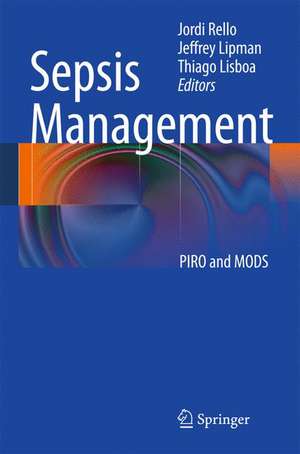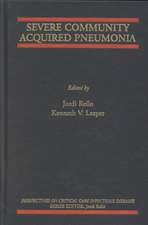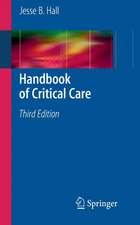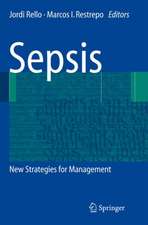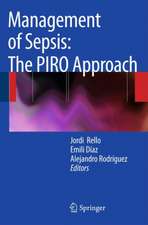Sepsis Management: PIRO and MODS
Editat de Jordi Rello, Jeffrey Lipman, Thiago Lisboaen Limba Engleză Hardback – 31 oct 2011
| Toate formatele și edițiile | Preț | Express |
|---|---|---|
| Paperback (1) | 776.41 lei 6-8 săpt. | |
| Springer Berlin, Heidelberg – 23 aug 2016 | 776.41 lei 6-8 săpt. | |
| Hardback (1) | 721.77 lei 3-5 săpt. | |
| Springer Berlin, Heidelberg – 31 oct 2011 | 721.77 lei 3-5 săpt. |
Preț: 721.77 lei
Preț vechi: 759.76 lei
-5% Nou
Puncte Express: 1083
Preț estimativ în valută:
138.18€ • 144.17$ • 115.83£
138.18€ • 144.17$ • 115.83£
Carte disponibilă
Livrare economică 19 februarie-05 martie
Preluare comenzi: 021 569.72.76
Specificații
ISBN-13: 9783642035180
ISBN-10: 3642035183
Pagini: 290
Ilustrații: VI, 243 p.
Dimensiuni: 155 x 235 x 17 mm
Greutate: 0.57 kg
Ediția:2012
Editura: Springer Berlin, Heidelberg
Colecția Springer
Locul publicării:Berlin, Heidelberg, Germany
ISBN-10: 3642035183
Pagini: 290
Ilustrații: VI, 243 p.
Dimensiuni: 155 x 235 x 17 mm
Greutate: 0.57 kg
Ediția:2012
Editura: Springer Berlin, Heidelberg
Colecția Springer
Locul publicării:Berlin, Heidelberg, Germany
Public țintă
Professional/practitionerCuprins
Multiorgan dysfunction syndrome (MODS): What is new?.- MODS scores. Which should I use?.- Why guidelines require reform.- PIRO concept and clinical failure.- PIRO-based approach for sepsis in immunocompromised patients: What's different?.- Intra-abdominal hypertension and MODS.- Assessing renal dysfunction in septic patients.- Monitoring myocardial dysfunction as part of sepsis management.- The lung in multi-organ failure.- Pathogens in severe sepsis. New paradigms for gram positive treatment.- Pathogens in severe sepsis. New paradigms for fungi treatment.- Importance of high creatinine clearance for antibacterial treatment in sepsis.- How do I adjust antimicrobial daily dosage in patients with MODS? A pharmacist’s contribution .- Improving outcomes in sepsis and septic shock: Getting it right the first time.
Notă biografică
Drs. Rello, Lipman and Lisboa participate in several critical care meetings with lectures on sepsis, antibiotic treatment and organ dysfunction. Every year they organize a meeting in Tarragona, Spain on the management of sepsis.
Textul de pe ultima copertă
This book is unique in approaching multiple organ dysfunction syndrome (MODS) from the perspective of its pathophysiological mechanism, and addressing aspects that are overlooked in most of the available literature. Eminent experts in the field from Europe and beyond offer new insights into risk stratification, severity assessment, and management of critically ill patients with sepsis. The principal focus is on recently developed concepts in infection management and in antibiotic use, bearing in mind that in these patients the pharmacokinetics of antibiotics are altered, affecting renal clearance and requiring dosage adjustments. The significance of the PIRO (predisposing factors, infection, response, organ dysfunction) model in the development of effective treatment strategies is emphasized. This book will be of interest and value to all who are involved in the treatment of, or research into, sepsis and MODS.
Caracteristici
Offers many new insights into risk stratification, severity assessment, and management of critically ill patients with sepsis Approaches MODS from the perspective of its pathophysiological mechanism and addresses aspects often overlooked in the literature Explores the significance of the PIRO model in the development of effective treatment strategies Written by eminent experts from Europe and beyond
